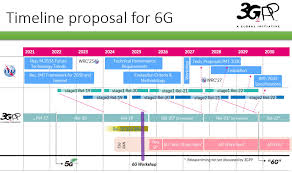The tandem of 5G and 6G is already rewriting what a smartphone can do: ultra-low latency and high bandwidth are enabling new phone features (edge AI, cloud XR, and instant cloud gaming) and accelerating 5G adoption worldwide, while early work on the 6G roadmap promises even deeper integration of sensing and AI — ushering in the era of edge AI in phones that can do far more locally and collaboratively with the network.
1. Introduction — Why networks shape the phone experience:
Smartphones are not islands: features that seem device-centric — real-time AR, live 4K streaming, instant AI editing — depend heavily on the network. The move from 4G to 5G brought a dramatic expansion of capabilities: higher throughput, lower latency, and stronger support for distributed compute (edge), which in turn enabled whole new classes of apps and user expectations. The road to 6G starts while 5G adoption continues to grow, and 6G research emphasizes AI-native networks and sensing — technologies that will again force OEMs to rethink phone hardware and software integration. Industry roadmaps and research groups are already marshaling standards and prototypes for 6G, with commercial expectations toward the early 2030s.
2. How 5G changed the mobile feature set (and adoption):
When 5G first arrived, the marketing focused on speed. But adoption and impact were driven by features that required more than raw Mbps:
- Ultra-low latency enabled interactive applications like cloud gaming and AR/VR experiences where reaction time matters.
- Massive bandwidth let phones stream multi-camera, multi-angle 4K/8K content and offload heavy compute to the cloud without unbearable delays.
- Network slicing and private 5G gave enterprises customized SLAs for reliability and security, opening phone use cases for industry.
- Mobile Edge Computing (MEC) brought compute physically closer to users and allowed phones to call on remote models for inference without high latency.
These advances made new phone features practical, not just theoretical — and they encouraged consumers to buy 5G-capable devices. Operators shifted toward Standalone (SA) 5G cores to unlock these features fully, and device makers incorporated multiplatform modems and antenna stacks to support diverse 5G bands, from mid-band to mmWave.
3. Key 5G network capabilities that enable phone innovation:
Below are five network capabilities that had direct, measurable effects on phone features:
1) Extremely high throughput:
5G delivers multi-hundreds of Mbps (and in good conditions multi-Gbps) to devices. That bandwidth makes seamless cloud-based image and video workflows possible — think live 4K uploads, multi-participant AR, and instant backup.
2) Ultra-low latency:
With round-trip latency often under 10 ms in modern networks and sub-millisecond feasible with edge placement, phones can interact with cloud services nearly in real-time. Critical for cloud gaming, remote control of devices, and latency-sensitive AR overlays.
3) Network slicing & QoS:
Network slicing allows operators to dedicate virtual network resources to specific services (e.g., an AR conference stream or industrial control). Phones can request or be assigned slices for guaranteed performance, shaping user experience.
4) Massive IoT and concurrency:
5G supports many more connected endpoints per cell than prior generations — enabling phones to be hubs for smart homes, wearables, and city-scale sensors.
5) Mobile Edge Computing (MEC):
By pushing compute to the edge, MEC reduces latency and allows phones to offload expensive AI inferences to nearby servers — a major factor for edge AI in phones and complex AR processing. Reports from GSMA highlight how 5G + edge provides the lowest-latency path for mobile applications, which frees devices from local constraints.
4. Real-world phone features 5G unlocked:
Here we list concrete phone features made feasible or popular by 5G networks.
1) Edge AI and on-device + network collaboration:

Edge AI refers to architectures where some inference happens in the device and heavier models run on nearby edge servers. Phones can now run low-latency, privacy-preserving AI tasks (e.g., instant language translation, live scene segmentation for AR) by splitting work between device NPU and MEC—improving responsiveness and battery life. Studies show edge inference reduces end-to-end latency substantially versus cloud-only processing.
2) Augmented Reality (AR) and Mixed Reality (XR):
True multi-user AR experiences with synchronized content require low latency and high bandwidth. 5G allows phones to stream real-time 3D assets and synchronize state across users, enabling collaborative design tools, remote assistance, and robust location-based gaming.
3) Cloud gaming & streaming:
Services such as cloud gaming can render frames on remote servers and stream them to phones at high frame rates. With 5G’s low latency, user inputs translate into near-instant actions on screens — turning even mid-range phones into high-quality gaming terminals.
4) Live production & multi-camera broadcasting:
5G’s reliability and uplink capacity enable live mobile broadcasting with multiple camera angles straight from phones. Newsrooms and sports broadcasters increasingly rely on 5G for remote production workflows, reducing the need for satellite links.
5) Instant AI camera enhancements:
Computational photography took a leap: phones can now perform real-time HDR stacking, multi-frame noise reduction, and AI-powered editing features that previously required desktop tools. Edge compute allows heavier algorithms to run with near-instant feedback.
6) Real-time translation and transcription:
By pairing on-device models with edge servers for fallback heavy lifting, phones support more accurate, faster real-time speech translation and contextual transcription — valuable for travel and global collaboration.
7) Sensor fusion and real-time positioning:
5G’s precise time synchronization and high bandwidth improve sensor fusion between phone sensors and networked beacons, enabling centimeter-level positioning for navigation and AR.
5. 5G adoption: numbers, drivers and device ecosystem:
5G is already the fastest-growing mobile broadband technology in history. By late 2023/early 2024 there were over a billion 5G connections globally; adoption accelerated through 2024 and 2025 thanks to device affordability, broader mid-band rollouts, and ecosystem support from chipmakers. Ericsson and GSMA reports note rapid 5G uptake in many markets and predict continued growth as lower-cost 5G chips enter millions of devices.
Drivers of 5G adoption:
- Affordable 5G chipsets in mid-range phones
- Operator incentives and low-cost 5G plans
- Compelling use cases (gaming, XR, enterprise private networks)
- Increasing availability of mid-band spectrum, which balances speed and coverage
Device ecosystem impact: OEMs integrated 5G modems with multi-band support (sub-6 GHz and mmWave) and improved antenna arrays. Chipmakers (Qualcomm, MediaTek) built modem-RF platforms that reduced BOM and increased integration, helping price points fall. Standards work (3GPP Releases through R19/R20) continues to add features that further enable phone capabilities.
6. What 6G promises and how it extends phone capabilities:
While 5G is still rolling out globally, research into 6G is well underway. Industry leaders and research bodies describe 6G as more than faster bits: it will be an AI-native, sensing-enabled, multi-modal network that fuses communication, sensing, and computing. That shift opens up new phone features and adoption drivers:
1) AI-native networking:
6G aims to bake AI into the network fabric — intelligent resource allocation, predictive QoS, and context-aware services. Phones will request services that the network predicts and optimizes proactively, enabling even lower perceived latency and smarter edge offload.
2) Integrated sensing and communication (ISAC):
6G will combine wireless communication and sensing: phones and base stations won’t just exchange data — they’ll sense environments (gesture recognition, occupancy, health monitoring) and support locationing with unprecedented precision. Such sensing could enable new safety and health features built into phones and services.
3) Terahertz bands & extreme bandwidth:
6G research envisions terahertz (THz) spectrum for ultra-high capacity links — enabling instantaneous transfer of huge datasets and seamless offloading of AR/VR world models, 3D maps, or cloud trained models. This bandwidth will shift how phones store and retrieve data, favoring dynamic streaming of large assets.
4) Semantic & task-oriented communications:
Emerging research into semantic communications suggests future networks may transmit meaning instead of raw bits, allowing phones to request and receive task-relevant information with far lower bandwidth. This is especially powerful for AR and multi-agent AI applications. (Recent academic work on semantic methods shows promising efficiency gains for future systems.)
5) Hyper-distributed compute & federated intelligence:
6G will enable tighter federation of device and network intelligence, so phones can participate in continuous federated learning while preserving privacy. Upgrades in secure compute and model sharing will create new phone features that improve over time.
Together, these 6G directions will catalyze novel phone features: continuous contextual awareness, higher-fidelity XR, instantaneous multi-device collaboration, and new sensing-based services previously unthinkable on a handheld. Industry roadmaps from Qualcomm and Ericsson emphasize AI and terahertz research as central pillars of 6G development.
7. 6G roadmap, standardization and timelines:

6G standardization and research are active across global bodies. Early activities — whitepapers, working groups and regional research hubs — set the direction. Recent FCC TIC/ TAC reports and industry whitepapers summarize 6G priorities: AI integration, terahertz, integrated sensing, and sustainability. Early commercialization remains targeted for the early 2030s, but incremental features (e.g., ISAC testbeds, semantic comms experiments) will appear earlier in niche deployments.
Stages to watch:
- 2024–2026: Research & trials — academia, industry labs publish prototypes and demonstrate ISAC/semantic concepts.
- 2026–2029: Pre-standardization (3GPP study items and initial candidate technologies).
- 2030–2033: Standardization maturity and early commercial rollouts in select markets.
Qualcomm and other vendors are already mapping chipset roadmaps to incorporate necessary RF and AI capabilities, and network vendors (Ericsson, Huawei, Nokia) are prototyping 6G baseband and THz front-ends.
8. How phone hardware and software will evolve:
Networks alone won’t create new phone features — phone makers must adapt hardware and OS stacks.
1) RF & antenna design:
Phones will carry more complex antenna arrays to handle multi-band 5G and future THz. Beamforming and multi-element MIMO will be more pervasive, requiring clever packaging and thermal design.
2) NPUs & heterogeneous compute:
Phone SoCs will integrate more powerful NPUs to handle local AI tasks and orchestrate hybrid edge collaboration. Manufacturers will balance on-device power and offload to MEC for heavier loads.
3) Thermal & battery management:
High throughput and heavy AI workloads drive thermal and energy challenges. New cooling solutions, dynamic voltage scaling and AI-driven power profiles will be standard.
4) Sensor suites:
To support 6G ISAC and richer experiences, phones will add novel sensors: LIDAR / ToF enhancements, mmWave sensing, more precise inertial measurement units (IMUs), and environmental sensors.
5) OS & APIs:
Mobile OS vendors will expose APIs for network slice awareness, edge compute invocation, and cross-device orchestration, making it easy for apps to take advantage of network capabilities.
6) Interoperability & SDKs:
Cloud and network vendors will ship SDKs that let developers call edge compute, request slices, or negotiate for deterministic latency — simplifying app development for network-aware features.
9. Telco features that change the user experience:
1) Network slicing on phones:
When a phone launches a VR meeting, the operator can allocate a slice with guaranteed bandwidth and latency. Android and iOS progressively added APIs to support 5G slicing signaling, enabling apps to request particular QoS. This turns the network into a co-developer for the app experience rather than a passive conduit.
2) Private 5G and enterprise mobility:
Companies deploy private 5G networks for factories and campuses — phones that support private network credentials get enterprise features like secure roaming, low-latency access to private cloud services, and specialized apps (robot control, AR maintenance).
4) Edge marketplaces:
Operators and cloud providers will host edge marketplaces: apps can request on-demand model inference at edge nodes (e.g., style transfer for photos), monetize micro-services, and negotiate latency/cost tradeoffs.
10. Industry case studies & pilots:
1) Education: 5G + Edge AR classrooms:
GSMA and operator pilots show 5G + edge enabling real-time interactive AR labs that offload heavy simulation to edge servers, improving learning outcomes in remote or under-resourced areas.
2) Healthcare: Remote procedures and monitoring:
Low latency combined with edge compute enables tele-medicine with real-time imaging and AR guidance for remote procedures. Hospitals piloting 5G private networks report reliable video feeds and remote device control.
3) Media & Live events:
Broadcasters use 5G uplinks from phones for multi-angle, low-latency feeds, reducing dependence on satellite trucks and providing flexible coverage for breaking news and sports.
11. Security, privacy and energy challenges (and mitigation):
As phones rely more on the network and edge compute, new risks arise:
1) Data privacy:
Offloading inference to edge nodes involves data transit and model privacy. Techniques like federated learning, homomorphic encryption and trusted execution environments help protect data while enabling collaborative intelligence.
2) Attack surface increase:
Network slices and edge services expand the attack surface. Operators and OEMs must harden endpoints, use zero-trust principles, and maintain rapid patching.
3) Energy and sustainability:
High throughput and heavy compute increase energy consumption. 6G research emphasizes sustainability: energy-efficient AI models, dynamic resource scaling, and green network designs will be essential to keep devices practical. Research and standards groups emphasize power efficiency in the 6G vision.
12. Consumer guidance: buying, upgrade timing and practical expectations
1) Should you upgrade to a 5G phone today?
If you value improved streaming, cloud gaming, AR experiences, or are in a market with mature 5G coverage, a 5G phone delivers clear benefits. For users in early-rollout markets, evaluate device cost vs. available 5G services.
2) What to check when buying a phone for 5G/6G features:
- Supported bands (mid-band & mmWave support if needed)
- Edge AI & NPU capability (for on-device plus edge collaboration)
- OS support for network slicing & APIs
- Thermal design (sustained performance under load)
- Ecosystem (apps & operator support for MEC and slices)
3) When to watch for 6G features:
6G hardware changes (THz RF, advanced sensing) will take time. Expect incremental features (better sensing, AI orchestration) in the late 2020s and early 2030s. Apps and developers should design for progressive enhancement — assume networks will continue to add capabilities that apps can exploit.
13. FAQs — quick answers:
Q: Will 6G make phones obsolete?
A: No — 6G will augment phone capabilities and enable new features, but phones remain the primary personal interface. 6G will change what phones can request from the network and what they can sense locally.
Q: Do I need mmWave for 5G benefits?
A: Not always. Mid-band 5G provides the best mix of coverage and throughput for most users; mmWave gives extreme hotspot speeds but limited range.
Q: Can 5G damage battery life?
A: Early 5G modems consumed more power, but modern chipsets and software power management have improved battery efficiency. Offloading to edge compute can also save device energy for heavy tasks.
Q: Will old apps automatically benefit from 5G/6G?
A: Apps must be adapted or updated to call edge services, request slices, or use low-latency paths — simply being on 5G won’t magically improve app behavior without developer changes.
14. Conclusion — the next five years for phones:
The combined trajectory of 5G and 6G is clear: networks are evolving from pipes to intelligent platforms, and phones are evolving from standalone compute devices to orchestrators of distributed intelligence. New phone features like advanced edge AI, high-fidelity XR, instantaneous collaborative tools, and network-assured experiences are already emerging because of 5G; early 6G research promises even more radical capabilities — sensing, terahertz bandwidth, and semantic communications — that will change how phones perceive and augment reality.
For consumers, this means richer experiences, new workflows, and more powerful mobile creativity. For OEMs and network operators, it means deep collaboration: phones and networks will co-design features, and the 6G roadmap will be a joint roadmap for device makers, telcos, and cloud providers. If you’re building apps, planning device purchases, or designing services, the right approach is future-aware: design for hybrid edge/device models today and plan to adopt network-native features as 5G matures and 6G arrives.
15. External links:
- GSMA — 5G and edge computing briefs and case studies. GSMA
- Ericsson — 6G overview and research page. ericsson.com
- Qualcomm — 6G research & roadmap. Qualcomm
- Ericsson Mobility Report — 5G adoption metrics and trends. coit.es
- FCC TAC 6G Working Group Report — standardization priorities. Federal Communications Commission
- https://resources.goanritsu.com/5g-mobile-devices/developing-a-6g-development-strategy-and-roadmap-2



Leave a Reply